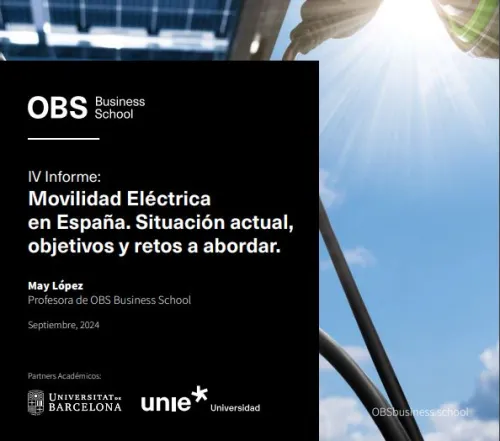
IV OBS Report: Electric Mobility. Current situation, goals and emerging challenges
Plug-in vehicle sales overtook diesel for the first time in Spain
- Electric vehicles in Europe and the USA are still priced 10-50% more expensive. In China they are cheaper than combustion vehicles.
- Spain on the verge of early compliance with the PNIEC 2025 electricity fleet target.
- Only 3% of the European and 1.4% of the Spanish vehicle fleet is made up of electric vehicles, a far cry from the targets set for 2030.
- Madrid, Catalonia, the Balearic Islands, the Canary Islands and the Basque Country are the regions that contribute most to meeting the electricity fleet targets set in the PNIEC. Far behind are Extremadura, Ceuta and Melilla, Castile and Leon and Galicia.
- Spanish public charging network is adequate enough to serve the current electric car fleet (only 6.31% of its capacity is used), although there is a lack of infrastructure for heavy vehicles and the public charging infrastructure still does not comply with the European regulations in terms of information availability, transparency and interoperability.
September 2024. OBS Business School, institution belonging to Planeta Formación y Universidades, publishes the IV Report on Electric Mobility 2024 conducted by May López, professor from the school and director of the platform Empresas por la Movilidad Sostenible (Companies for Sustainable Mobility).In this edition, the report assesses whether the progress made over the last year is sufficient to ensure that Spain meets national targets and commitments (to have 540,000 plug-in electric vehicles by 2025 and 5.5 million by 2030) and international commitments (to provide infrastructure to service the 30 million cars and 80,000 zero-emission trucks operating on Europe's roads by 2030).
For the first half of 2024, 100% electric passenger cars (BEVs) in Europe registered a modest year-on-year growth in registrations of 1.3% (712,637 units) and plug-in hybrids a decline of 2.5% (392,284 units) and still account for only 3% of all cars currently on EU roads, 1.4% nationally. Non-plug-in hybrids have increased their market share, but they do not contribute to the targets set by the EU. Spain is meeting up to 99% of the PNIEC intermediate target of 540,000 electric vehicles in Spain by 2025. However, this figure does not even represent 10% of the 5.5 million target for 2030. The Community of Madrid is proportionally the province that contributes most to meeting the compliance target, followed by Catalonia, the Balearic Islands, the Canary Islands and the Basque Country. In comparison, Extremadura, Ceuta and Melilla, Castile and Leon and Galicia are at the bottom of the ranking.
A decade ago, seven out of ten Spaniards saw the electric car as the solution for urban mobility, however, this percentage has now fallen to 18% (Alphabet data). Among the main reasons are the price, the limited charging network and the vehicle's autonomy. Nevertheless, for the first time in Spain, in the first half of the year 2024, the new sales share of plug-in cars surpassed diesel and it is expected by 2024 the sale of electric vehicles in the world will reach 17 million, distributed mainly in China (45%), Europe (25%) and the USA (11%).
First hurdle: price
More than 60% of electric cars sold in China in 2023 were already cheaper than their combustion engine counterparts, however, they remain between 10% and 50% more expensive in Europe and the United States. While this price gap is beginning to narrow due to the lower operating and maintenance costs of electric vehicles, there are transport vehicle segments, such as vans, buses and trucks, where entry hurdles remain significant. Price is a deterrent factor and therefore the sale of electric vehicles is strongly linked to subsidies or purchase incentives. The Royal Decree-Law 5/2023 of 28 June marks a significant milestone in this direction as it introduces deductions in personal income tax, along with the MOVES programme in its several forms, or the PERTE VEC. The new electric vehicle sheet included in the CAE (Energy Saving Certificates) provides an extra aid which, if applied to the fleet sold in 2023, would mean an additional 28.5 million euros, as well as continuity in time and agility in its application. While there is a strong commitment to electric mobility, there are other measures that would undoubtedly help to boost its development: streamlining current procedures, offering direct, non-taxable aids that can be processed quickly and linked to sustainability, setting up a specific line of current and future aids for commercial vehicles in distribution, making the geographical aids distribution for commercial vehicles based on the transport company registration and not on the population census, as is currently the case, or paying special attention to the SMEs and the self-employed, the weakest link in the chain, as many of the aids are currently aimed towards large companies. To enable easier access, the European Commission has raised the cap on the amount a transport company can receive from the government, known as ‘de minimis’, to 300.000 euros.
In addition to all these available aids, other initiatives are emerging aimed at democratising the access to electric vehicles for people and groups with lower income, such as the social leasing implemented in France. Or those offered by companies to encourage people to shift to electric vehicles. One example is Nacex, whose financial aid programme is aimed at facilitating the acquisition of more sustainable vehicles by its franchise network.
In any case, competition between manufacturers, the drop in battery prices and the arrival of electric cars from China is making this type of vehicle more affordable, however, the possible imposition of customs tariffs in Europe on Chinese vehicles and the gradual removal of purchase incentives in some countries may affect this tendency.
Second hurdle: the charging infrastructure
The public charging infrastructure in Spain is currently sufficient to meet the needs of the electric car fleet on national roads, with only 6.31% of its capacity actually being used. However, the lack of electric charging stations in rural areas and the limited power available for recharging heavy vehicles is a challenge. In 2023, almost one in three public charging points were installed and operational in Spain, resulting in a ratio of 15 electric vehicles per public charger ( 20 per public charger the previous year). The Autonomous Communities with the most vehicles per charging point are Madrid, Catalonia and the Canary Islands. In contrast, the Basque Country, Navarre, Aragon, La Rioja and Asturias hold the best ratio.
Available power has also been improved and now stands at 1.4 kW per vehicle (in 2023), above the European average (1.2 kW), yet far behind China's ratios (8 electric vehicles per public charger and 3.46 kW power). Despite this progress, Spain is still far from meeting the commitments set for 2030 (340,000 public charging points). 96% of the public charging infrastructure in Spain is managed by only 10 of the 80 operating companies. Iberdrola leads the way with the management of one in three public charging points and leadership in 37 Spanish provinces. Most of the operators agree on the challenges when it comes to setting up an electro-lighting station: between 24 and 36 months elapse from the request for the connection point from the distributor to the start-up, three or four times longer than in France, Belgium, Italy, Switzerland or Austria. In some cases, the longest time it has taken to connect to the network has exceeded three years.
At the end of the first half of this year, there were just over 34,000 public charging points in operation in Spain, which are obliged to provide transparent and updated information on their prices, facilities, opening hours and characteristics, as required by the European Union. However, only 20,000 of them do so, meaning that 40.9% of the information is missing, largely due to national exemptions for charging points smaller than 22 kW. The OBS report states that "this should be extended to the entire public network in order to plan the deployment of this infrastructure in an efficient way as well as to provide reliable, consolidated and accurate information to customers purchasing an electrified vehicle. In addition, users should be able to pay easily with payment cards or contactless devices, without the need for a subscription and prices should be fully transparent". The lack of complete interoperability of the public charging infrastructure installed in Spain means that the price of charging is more expensive than in other European countries, despite the fact of having a lower energy cost in Spain.
Third hurdle: the vehicle's autonomy
Technological developments have played a key role in improving significantly the battery efficiency and performance, resulting in longer autonomy and shorter recharging times. Increasing investment and competition in the electric vehicle market has driven innovation and expanded the range of models and options available to buyers. This has not only led to a greater range, but has also improved the quality and functionality of vehicles, further accelerating the uptake of this technology.
An adequate charging network reduces range concerns and enables vehicles with smaller batteries, reducing costs and demand for critical materials. However, SUVs remain the most registered segment in both Europe and Spain, where they represent 59% of the overall car registrations in 2023. These are large, more polluting and less efficient models powered by batteries 25% larger than a medium-sized electric car with a similar range. If all electric SUVs sold in 2023 had instead been mid-size cars, around 6,000 tonnes of lithium, 30,000 tonnes of nickel, almost 7,000 tonnes of cobalt and more than 8,000 tonnes of manganese could have been avoided.
Support and information to boost electric mobility
‘If Spain wishes to meet the EU goals, it is essential to offer solutions and aids, but also provide information on the advantages of using electric vehicles from an environmental, economic and safety point of view; to raise awareness about the advantages of achieving energy independence as a country and as a user; facilitate the TCO allowing an informed purchasing decision; reduce times by streamlining and simplifying procedures; provide transparent information on available network capacity; control fraud and legislate both the access and connection regulations to the electricity networks and access to information on availability and distribution of capacity', the report concludes.
Content written by:
Carmen García-Trevijano
OBS Business School Press Office

